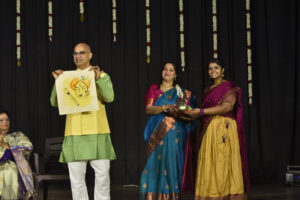An arangetram marks a dancer’s transition from student to performer, and with it comes months (often years) of preparation. To make this milestone smooth, having a structured arangetram checklist is essential. From the first vow of commitment (sankalpam) to the final bow on stage, every step requires planning and precision. This blog walks you through the ultimate Bharatanatyam arangetram checklist, ensuring you don’t miss a single detail while preparing for this sacred and celebratory journey.
1. 1 Year Before – The Sankalpam Begins
The journey officially starts with the sankalpam, the solemn decision to undertake the Bharatanatyam Arangetram procedure. At this stage, students and their families should consult with the guru to decide if the dancer is ready. The decision usually comes after years of training and mastery of the repertoire. This is also the time to tentatively choose a date, set a budget, and begin envisioning the scale of the celebration. Some families even book the venue early, especially if it’s a popular auditorium.
2. 8–10 Months Before – Foundation Laying
This period is all about laying a strong foundation for the performance. Families should start researching musicians, photographers, and videographers, as these professionals are often booked months in advance. Costume planning begins here, with designs and colors chosen to suit the dancer’s personality and stage lighting. Parents may also start exploring ideas for Arangetram gifts that will be offered to guests or to the guru. Equally important is confirming the repertoire with the guru—finalizing the pieces the dancer will perform ensures focused practice in the months ahead.
3. 6 Months Before – Vision into Motion
Half a year before the event, the arangetram checklist should include formal bookings. Reserve the orchestra, confirm the stage and lighting arrangements, and finalize costume orders with tailors or designers. Begin planning the Arangetram Invitation, which should reflect the cultural elegance of the ceremony. Many families include images of Nataraja, temple motifs, or traditional Bharatanatyam elements. It’s also wise to start considering stage décor and themes, such as floral arrangements or backdrops that highlight the dancer without overpowering the performance.
4. 3 Months Before – Time to Finalize
At the three-month mark, rehearsals intensify. The dancer should be practicing the full repertoire with live musicians, ensuring synchronization with the mridangam, violin, veena, and vocalists. Families must finalize Arangetram Invitation printing and distribution. Guest lists should be organized, keeping in mind the capacity of the venue. Makeup artists, hairstylists, and costume drapers should be booked. Additionally, travel arrangements for relatives or special guests can be made during this time. This stage also includes budgeting for hospitality—food, drinks, and thank-you tokens for attendees.
5. 1 Month Before – Crunch Time
One month before the performance, everything begins to fall into place. The Bharatanatyam arangetram checklist at this stage includes costume fittings, jewelry trials, and makeup test runs. The dancer should rehearse in full costume at least once to ensure comfort and confidence. Stage décor providers should be contacted for final adjustments, and the catering team must be confirmed. This is also the best time to finalize the order of the event day schedule, ensuring smooth transitions between speeches, dances, and acknowledgments.
6. 3 Weeks Before – The Details
In these crucial weeks, it’s all about the finer details. Seating arrangements for guests should be planned, keeping family members, VIPs, and musicians in mind. Test the sound system and ensure microphones are sufficient for both musicians and speeches. Prepare a checklist of Arangetram gifts, ensuring they are packed, labeled, and ready for distribution. The dancer should continue rehearsing daily, focusing not just on stamina but also on abhinaya (expressions) to bring stories alive for the audience.
7. 1 Week Before – The Sacred Countdown
As the final week begins, rehearsals with the full orchestra must be treated like the actual performance. Costumes should be ironed, jewelry polished, and accessories like ghungroo checked for wear and tear. The arangetram checklist also includes preparing an emergency kit with pins, safety threads, extra makeup, and backup costume elements. Families should arrange a rehearsal at the actual venue if possible, allowing the dancer to familiarize themselves with the stage, lighting, and acoustics.
8. 2 Days Before – Calm Before the Stage
Two days before the arangetram, families should focus on rest, relaxation, and mental preparation. The dancer should avoid overexertion but may rehearse lightly to stay sharp. Costumes, ornaments, and makeup must be neatly organized and packed. Confirm arrival times with all professionals—musicians, photographers, and decorators. Parents often use this time to ensure the hospitality arrangements are finalized, from snacks to post-performance meals. The Bharatanatyam Arangetram procedure requires both discipline and calmness, so meditation or quiet reflection can help the dancer center themselves.
9. On the Day – The Arangetram
The big day arrives, filled with both excitement and nervous energy. The dancer dresses in their costume, adorned with jewelry and flowers, embodying centuries of tradition. The program begins with the traditional pushpanjali or alarippu, gradually progressing through the repertoire. The audience witnesses the dancer’s transformation, applauding the culmination of years of training. Arangetram Invitation cards are often placed at entry points for guests to take home as keepsakes. The ceremony concludes with gratitude expressed to the guru, musicians, and family members, often accompanied by distributing Arangetram gifts.
10. Bonus Tip – Record Your Journey
One aspect often overlooked in the arangetram checklist is documenting the journey. Beyond professional photography and videography, families can create personal keepsakes by capturing behind-the-scenes moments—late-night rehearsals, costume fittings, and candid guru-student interactions. These memories will be treasured for years, serving as a reminder of the discipline, love, and joy that shaped the dancer’s arangetram journey.
Conclusion
An arangetram is more than just a performance; it is a rite of passage steeped in tradition, discipline, and devotion. With a detailed Bharatanatyam arangetram checklist, families can navigate the process smoothly, ensuring no important detail is overlooked. From the initial sankalpam to the final curtain call, every step contributes to the dancer’s transformation. Whether it’s choosing the right Arangetram gifts, sending the perfect Arangetram Invitation, or following the Bharatanatyam Arangetram procedure, preparation ensures that the day unfolds with grace and joy.





